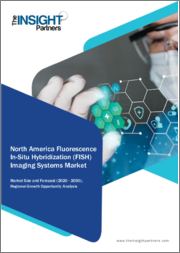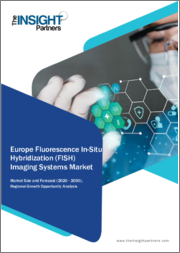
|
시장보고서
상품코드
1498655
세계의 FISH(Fluorescence In Situ Hybridization) 프로브 시장 조사 보고서 : 산업 분석, 규모, 점유율, 성장, 동향 예측(2024-2032년)Global Fluorescence In Situ Hybridization Probe Market Research Report - Industry Analysis, Size, Share, Growth, Trends and Forecast 2024 to 2032 |
||||||
FISH 프로브 시장의 세계 수요는 2023년 8억 7,875만 달러에서 2032년에는 약 10억 475만 달러 규모에 이를 것으로 추정되며, 조사 기간 2024년 CAGR은 1.5%으로 예상됩니다.
FISH 프로브는 염색체 내의 특정 DNA 서열을 검출하고 지역화하는 분자 도구입니다. 이 프로브는 형광 염료로 표지되고 샘플의 상보적인 DNA 서열에 혼성화됩니다. 형광 현미경으로 관찰하면, 프로브는 발광하고 표적 유전 물질의 존재와 위치를 나타냅니다. FISH 프로브는 염색체 이상, 유전자 융합, 카피수의 변이를 확인하기 위해 유전자 연구, 임상 진단, 암 연구 등에서 널리 사용되고 있습니다. 이 기술은 세포의 유전자 구성에 대한 고해상도 통찰력을 제공하고 진단을 돕고 치료 전략을 안내합니다.
시장 역학
유전성 질환, 감염증, 암의 급증은 염색체 이상, 유전자 변이, 병원 미생물을 높은 특이성과 감도로 검출하는 FISH 프로브를 이용한 분자진단 검사에 대한 수요를 견인하고 있습니다. 이러한 질병 부담 증가는 임상 현장에서 정확하고 신뢰할 수 있는 유전자 검사법의 중요성을 강조하고 FISH 프로브 시장 수요를 부추기고 있습니다. 프로브 설계, 형광 색소화학, 이미징 기술의 진보에 의해 신호 대 노이즈비, 다중화 기능, 자동화 기능을 강화한 혁신적인 FISH 프로브 분석이 개발되어 연구자나 임상의가 복잡한 게놈 분석을 보다 효율 적이고 정확하게 실시할 수 있게 되어 있습니다. 게다가 연구, 창약, 맞춤형 의료에 있어서의 FISH 프로브의 용도 확대가, 다양한 생물학적 샘플이나 질환 모델에 있어서의 유전자 발현 패턴, DNA 복제 역학, 염색체의 공간적 구성의 연구를 가능하게 함으로써, 시장 확대의 원동력이 되고 있습니다.
또한, 종양학 및 감염에 대한 동반진단 및 표적 치료 접근법의 채용 증가는 환자 계층화, 치료 선택 및 질병 모니터링을위한 동반진단 도구로서 FISH 프로브 시장 수요를 증가시킵니다. 또한 분자진단과 개별화의료에 대한 규제 프레임워크과 상환정책이 지지되고 있어 제품의 품질, 안전성, 상환범위를 확보함으로써 시장 성장을 가속하고 있습니다. 그러나 프로브의 고가격과 특수 장비의 필요성은 향후 수년간 FISH 프로브 시장 성장의 과제가 될 수 있습니다.
이 조사 보고서는 Porter's Five Forces 모델, 시장 매력 분석, 밸류체인 분석을 대상으로 합니다. 이러한 도구는 업계의 구조를 명확하게 파악하고 세계 수준에서 경쟁의 매력을 평가하는 데 도움이 됩니다. 또한, 이러한 도구는 FISH 프로브 세계 시장에서 각 부문을 종합적으로 평가할 수 있습니다. FISH 프로브 산업의 성장과 동향은 이 연구에 전반적인 접근을 제공합니다.
시장 세분화
FISH(Fluorescence In Situ Hybridization) 프로브 시장 세분화는 국가 및 지역별 부문에 대한 상세한 데이터를 제공함으로써 전략 담당자가 각 제품 및 서비스의 목표 계층을 식별하고 향후 비즈니스 기회에 도움이 될 수 있습니다.
유형별
- DNA
- RNA(mRNA, miRNA, 기타)
기술별
- Q피쉬
- 플로 FISH
- 기타
용도별
- 암 조사(폐암, 유방암, 방광암, 혈액암, 전립선암, 자궁경부암, 기타)
- 유전자 질환
- 기타
최종 사용자별
- 연구 및 학술기관
- 진단센터
- 기타
지역 분석
이 섹션에서는 북미, 유럽, 아시아태평양, 라틴아메리카, 중동 및 아프리카에서 형광 In Situ 하이브리드 화(FISH) 프로브 시장의 현재 및 미래 수요를 강조하는 지역 전망을 다룹니다. 또한이 보고서는 모든 지역에서 개별 용도 부문 수요, 추정 및 예측에 중점을 둡니다.
요청이 있으시면 저희에게 연락하십시오. 당사의 설문조사팀은 고객의 요구에 따라 맞춤형 보고서를 제공할 수 있습니다.
목차
제1장 서문
제2장 주요 요약
- 시장의 하이라이트
- 세계 시장 현황
제3장 FISH 프로브-산업 분석
- 소개: 시장 역학
- 시장 성장 촉진요인
- 시장 성장 억제요인
- 시장 기회
- 업계 동향
- Porter's Five Forces 분석
- 시장의 매력 분석
제4장 밸류체인 분석
- 밸류체인 분석
- 원재료 분석
- 원재료 리스트
- 원재료 제조업체 리스트
- 주요 원재료의 가격 동향
- 잠재적 구매자 목록
- 마케팅 채널
- 직접 마케팅
- 간접 마케팅
- 마케팅 채널 발전 동향
제5장 FISH 프로브 세계 시장 분석 : 유형별
- 개요 : 유형별
- 분석 및 예측 데이터 분석 : 유형별
- DNA
- RNA(mRNA, miRNA, 기타)
제6장 FISH 프로브 세계 시장 분석 : 기술별
- 개요 : 기술별
- 분석 및 예측 데이터 분석 : 기술별
- Q FISH
- 플로우 FISH
- 기타
제7장 FISH 프로브 세계 시장 분석 : 용도별
- 개요 : 용도별
- 분석 및 예측 데이터 분석 : 용도별
- 암 조사(폐암, 유방암, 방광암, 혈액암, 전립선암, 자궁경부암, 기타)
- 유전자 질환
- 기타
제8장 FISH 프로브 세계 시장 분석 : 최종 사용자별
- 개요: 최종 사용자별
- 분석 및 예측 데이터 분석 : 최종 사용자별
- 연구 및 학술기관
- 진단센터
- 기타
제9장 형광 In Situ 하이브리드화 프로브 세계 시장 분석 : 지역별
- 전망 : 지역별
- 소개
- 북미의 매출 분석
- 개요, 실적과 예측
- 북미 : 부문별
- 북미 : 국가별
- 미국
- 캐나다
- 멕시코
- 유럽의 매출 분석
- 개요, 실적과 예측
- 유럽 : 부문별
- 유럽: 국가별
- 영국
- 프랑스
- 독일
- 이탈리아
- 러시아
- 기타 유럽
- 아시아태평양 매출분석
- 개요, 실적과 예측
- 아시아태평양 : 부문별
- 아시아태평양 : 국가별
- 중국
- 인도
- 일본
- 한국
- 호주
- 동남아시아
- 기타 아시아태평양
- 라틴아메리카의 매출 분석
- 개요, 실적과 예측
- 라틴아메리카 : 부문별
- 라틴아메리카 : 국가별
- 브라질
- 아르헨티나
- 페루
- 칠레
- 기타 라틴아메리카
- 중동 및 아프리카의 매출 분석
- 개요, 실적과 예측
- 중동 및 아프리카 : 부문별
- 중동 및 아프리카: 국가별
- 사우디아라비아
- 아랍에미리트(UAE)
- 이스라엘
- 남아프리카
- 기타 중동 및 아프리카
제10장 FISH 프로브 기업경쟁 구도
- FISH 프로브 시장 경쟁
- 제휴/공동 연구/협정
- 합병 및 인수
- 신제품 발매
- 기타 개발
제11장 기업 프로파일
- 주요 기업의 시장 점유율 분석
- 시장 집중도
- Genemed Biotechnologies Inc.
- PerkinElmer Inc.
- F. Hoffmann-La Roche AG
- Abnova Corporation
- Oxford Gene Technologies
- Life Science Technologies
- Biosearch Technologies Inc.
- Biocare Medical LLC
- Abbott Laboratories
- Agilent Technologies
The global demand for Fluorescence In Situ Hybridization Probe Market is presumed to reach the market size of nearly USD 1004.75 Million by 2032 from USD 878.75 Million in 2023 with a CAGR of 1.5% under the study period 2024-2032.
Fluorescence in situ hybridization (FISH) probes are molecular tools that detect and localize specific DNA sequences within chromosomes. These probes are labeled with fluorescent dyes and hybridize to their complementary DNA sequences in the sample. When viewed under a fluorescence microscope, the probes emit light, revealing the presence and location of the target genetic material. FISH probes are widely used in genetic research, clinical diagnostics, and cancer studies to identify chromosomal abnormalities, gene fusions, and copy number variations. This technique provides high-resolution insights into the genetic makeup of cells, aiding in diagnosis and guiding treatment strategies.
MARKET DYNAMICS
The surging prevalence of genetic disorders, infectious diseases, and cancer drives demand for molecular diagnostic tests that utilize FISH probes to detect chromosomal aberrations, gene mutations, and pathogenic microorganisms with high specificity and sensitivity. This growing disease burden underscores the importance of accurate and reliable genetic testing methods in clinical practice, fuelling market demand for fluorescence in situ hybridization probes. Advancements in probe design, fluorophore chemistry, and imaging technologies have led to the development of innovative FISH probe assays that offer enhanced signal-to-noise ratios, multiplexing capabilities, and automation features, enabling researchers and clinicians to perform complex genomic analyses with greater efficiency and precision. Additionally, expanding applications of FISH probes in research, drug discovery, and personalized medicine drive market expansion by enabling the study of gene expression patterns, DNA replication dynamics, and spatial organization of chromosomes in diverse biological samples and disease models.
Moreover, the increasing adoption of companion diagnostics and targeted therapy approaches in oncology and infectious diseases augment market demand for fluorescence in situ hybridization probes as companion diagnostic tools for patient stratification, treatment selection, and disease monitoring. Furthermore, supportive regulatory frameworks and reimbursement policies for molecular diagnostics and personalized medicine drive market growth by ensuring product quality, safety, and reimbursement coverage. However, the high cost of probes and the need for specialized equipment may challenge the fluorescence in situ hybridization probe market growth in the coming years.
The research report covers Porter's Five Forces Model, Market Attractiveness Analysis, and Value Chain analysis. These tools help to get a clear picture of the industry's structure and evaluate the competition attractiveness at a global level. Additionally, these tools also give an inclusive assessment of each segment in the global market of Fluorescence In Situ Hybridization Probe. The growth and trends of Fluorescence In Situ Hybridization Probe industry provide a holistic approach to this study.
MARKET SEGMENTATION
This section of the Fluorescence In Situ Hybridization Probe market report provides detailed data on the segments at country and regional level, thereby assisting the strategist in identifying the target demographics for the respective product or services with the upcoming opportunities.
By Type
- DNA
- RNA (mRNA, miRNA, Other)
By Technology
- Q FISH
- FLOW FISH
- Others
By Application
- Cancer Research (Lung, Breast, Bladder, Blood, Prostrate, Cervical, Others)
- Genetic Diseases
- Others
By End User
- Research & Academic Institutes
- Diagnostic Centers
- Others
REGIONAL ANALYSIS
This section covers the regional outlook, which accentuates current and future demand for the Fluorescence In Situ Hybridization Probe market across North America, Europe, Asia-Pacific, Latin America, and Middle East & Africa. Further, the report focuses on demand, estimation, and forecast for individual application segments across all the prominent regions.
The research report also covers the comprehensive profiles of the key players in the market and an in-depth view of the competitive landscape worldwide. The major players in the Fluorescence In Situ Hybridization Probe market include Genemed Biotechnologies Inc., PerkinElmer Inc., F. Hoffmann-La Roche AG, Abnova Corporation, Oxford Gene Technologies, Life Science Technologies, Biosearch Technologies Inc., Biocare Medical LLC, Abbott Laboratories, Agilent Technologies. This section consists of a holistic view of the competitive landscape that includes various strategic developments such as key mergers & acquisitions, future capacities, partnerships, financial overviews, collaborations, new product developments, new product launches, and other developments.
In case you have any custom requirements, do write to us. Our research team can offer a customized report as per your need.
TABLE OF CONTENTS
1. PREFACE
- 1.1. Report Description
- 1.1.1 Objective
- 1.1.2 Target Audience
- 1.1.3 Unique Selling Proposition (USP) & offerings
- 1.2. Research Scope
- 1.3. Research Methodology
- 1.3.1 Market Research Process
- 1.3.2 Market Research Methodology
2. EXECUTIVE SUMMARY
- 2.1. Highlights of Market
- 2.2. Global Market Snapshot
3. FLUORESCENCE IN SITU HYBRIDIZATION PROBE - INDUSTRY ANALYSIS
- 3.1. Introduction - Market Dynamics
- 3.2. Market Drivers
- 3.3. Market Restraints
- 3.4. Opportunities
- 3.5. Industry Trends
- 3.6. Porter's Five Force Analysis
- 3.7. Market Attractiveness Analysis
- 3.7.1 Market Attractiveness Analysis By Type
- 3.7.2 Market Attractiveness Analysis By Technology
- 3.7.3 Market Attractiveness Analysis By Application
- 3.7.4 Market Attractiveness Analysis By End User
- 3.7.5 Market Attractiveness Analysis By Region
4. VALUE CHAIN ANALYSIS
- 4.1. Value Chain Analysis
- 4.2. Raw Material Analysis
- 4.2.1 List of Raw Materials
- 4.2.2 Raw Material Manufactures List
- 4.2.3 Price Trend of Key Raw Materials
- 4.3. List of Potential Buyers
- 4.4. Marketing Channel
- 4.4.1 Direct Marketing
- 4.4.2 Indirect Marketing
- 4.4.3 Marketing Channel Development Trend
5. GLOBAL FLUORESCENCE IN SITU HYBRIDIZATION PROBE MARKET ANALYSIS BY TYPE
- 5.1. Overview By Type
- 5.2. Historical and Forecast Data Analysis By Type
- 5.3. DNA Historic and Forecast Sales By Regions
- 5.4. RNA (mRNA, miRNA, Other) Historic and Forecast Sales By Regions
6. GLOBAL FLUORESCENCE IN SITU HYBRIDIZATION PROBE MARKET ANALYSIS BY TECHNOLOGY
- 6.1. Overview By Technology
- 6.2. Historical and Forecast Data Analysis By Technology
- 6.3. Q FISH Historic and Forecast Sales By Regions
- 6.4. FLOW FISH Historic and Forecast Sales By Regions
- 6.5. Others Historic and Forecast Sales By Regions
7. GLOBAL FLUORESCENCE IN SITU HYBRIDIZATION PROBE MARKET ANALYSIS BY APPLICATION
- 7.1. Overview By Application
- 7.2. Historical and Forecast Data Analysis By Application
- 7.3. Cancer Research (Lung, Breast, Bladder, Blood, Prostrate, Cervical, Others) Historic and Forecast Sales By Regions
- 7.4. Genetic Diseases Historic and Forecast Sales By Regions
- 7.5. Others Historic and Forecast Sales By Regions
8. GLOBAL FLUORESCENCE IN SITU HYBRIDIZATION PROBE MARKET ANALYSIS BY END USER
- 8.1. Overview By End User
- 8.2. Historical and Forecast Data Analysis By End User
- 8.3. Research & Academic Institutes Historic and Forecast Sales By Regions
- 8.4. Diagnostic Centers Historic and Forecast Sales By Regions
- 8.5. Others Historic and Forecast Sales By Regions
9. GLOBAL FLUORESCENCE IN SITU HYBRIDIZATION PROBE MARKET ANALYSIS BY GEOGRAPHY
- 9.1. Regional Outlook
- 9.2. Introduction
- 9.3. North America Sales Analysis
- 9.3.1 Overview, Historic and Forecast Data Sales Analysis
- 9.3.2 North America By Segment Sales Analysis
- 9.3.3 North America By Country Sales Analysis
- 9.3.4 United States Sales Analysis
- 9.3.5 Canada Sales Analysis
- 9.3.6 Mexico Sales Analysis
- 9.4. Europe Sales Analysis
- 9.4.1 Overview, Historic and Forecast Data Sales Analysis
- 9.4.2 Europe By Segment Sales Analysis
- 9.4.3 Europe By Country Sales Analysis
- 9.4.4 United Kingdom Sales Analysis
- 9.4.5 France Sales Analysis
- 9.4.6 Germany Sales Analysis
- 9.4.7 Italy Sales Analysis
- 9.4.8 Russia Sales Analysis
- 9.4.9 Rest Of Europe Sales Analysis
- 9.5. Asia Pacific Sales Analysis
- 9.5.1 Overview, Historic and Forecast Data Sales Analysis
- 9.5.2 Asia Pacific By Segment Sales Analysis
- 9.5.3 Asia Pacific By Country Sales Analysis
- 9.5.4 China Sales Analysis
- 9.5.5 India Sales Analysis
- 9.5.6 Japan Sales Analysis
- 9.5.7 South Korea Sales Analysis
- 9.5.8 Australia Sales Analysis
- 9.5.9 South East Asia Sales Analysis
- 9.5.10 Rest Of Asia Pacific Sales Analysis
- 9.6. Latin America Sales Analysis
- 9.6.1 Overview, Historic and Forecast Data Sales Analysis
- 9.6.2 Latin America By Segment Sales Analysis
- 9.6.3 Latin America By Country Sales Analysis
- 9.6.4 Brazil Sales Analysis
- 9.6.5 Argentina Sales Analysis
- 9.6.6 Peru Sales Analysis
- 9.6.7 Chile Sales Analysis
- 9.6.8 Rest of Latin America Sales Analysis
- 9.7. Middle East & Africa Sales Analysis
- 9.7.1 Overview, Historic and Forecast Data Sales Analysis
- 9.7.2 Middle East & Africa By Segment Sales Analysis
- 9.7.3 Middle East & Africa By Country Sales Analysis
- 9.7.4 Saudi Arabia Sales Analysis
- 9.7.5 UAE Sales Analysis
- 9.7.6 Israel Sales Analysis
- 9.7.7 South Africa Sales Analysis
- 9.7.8 Rest Of Middle East And Africa Sales Analysis
10. COMPETITIVE LANDSCAPE OF THE FLUORESCENCE IN SITU HYBRIDIZATION PROBE COMPANIES
- 10.1. Fluorescence In Situ Hybridization Probe Market Competition
- 10.2. Partnership/Collaboration/Agreement
- 10.3. Merger And Acquisitions
- 10.4. New Product Launch
- 10.5. Other Developments
11. COMPANY PROFILES OF FLUORESCENCE IN SITU HYBRIDIZATION PROBE INDUSTRY
- 11.1. Top Companies Market Share Analysis
- 11.2. Market Concentration Rate
- 11.3. Genemed Biotechnologies Inc.
- 11.3.1 Company Overview
- 11.3.2 Company Revenue
- 11.3.3 Products
- 11.3.4 Recent Developments
- 11.4. PerkinElmer Inc.
- 11.4.1 Company Overview
- 11.4.2 Company Revenue
- 11.4.3 Products
- 11.4.4 Recent Developments
- 11.5. F. Hoffmann-La Roche AG
- 11.5.1 Company Overview
- 11.5.2 Company Revenue
- 11.5.3 Products
- 11.5.4 Recent Developments
- 11.6. Abnova Corporation
- 11.6.1 Company Overview
- 11.6.2 Company Revenue
- 11.6.3 Products
- 11.6.4 Recent Developments
- 11.7. Oxford Gene Technologies
- 11.7.1 Company Overview
- 11.7.2 Company Revenue
- 11.7.3 Products
- 11.7.4 Recent Developments
- 11.8. Life Science Technologies
- 11.8.1 Company Overview
- 11.8.2 Company Revenue
- 11.8.3 Products
- 11.8.4 Recent Developments
- 11.9. Biosearch Technologies Inc.
- 11.9.1 Company Overview
- 11.9.2 Company Revenue
- 11.9.3 Products
- 11.9.4 Recent Developments
- 11.10. Biocare Medical LLC
- 11.10.1 Company Overview
- 11.10.2 Company Revenue
- 11.10.3 Products
- 11.10.4 Recent Developments
- 11.11. Abbott Laboratories
- 11.11.1 Company Overview
- 11.11.2 Company Revenue
- 11.11.3 Products
- 11.11.4 Recent Developments
- 11.12. Agilent Technologies
- 11.12.1 Company Overview
- 11.12.2 Company Revenue
- 11.12.3 Products
- 11.12.4 Recent Developments















